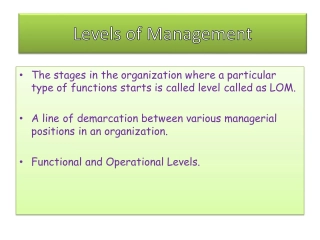Understanding Management of Receivables in Business
Covering various aspects of receivables management, this session explores the importance of managing credit sales effectively. Topics include defining receivables, cost-benefit analysis, credit evaluation, credit terms, policy control, and more. Learn about the benefits and costs of receivables, aspects of management, credit evaluation methods, and sources of information for evaluating customer creditworthiness.
Download Presentation
Please find below an Image/Link to download the presentation.
The content on the website is provided AS IS for your information and personal use only. It may not be sold, licensed, or shared on other websites without obtaining consent from the author. Download presentation by click this link. If you encounter any issues during the download, it is possible that the publisher has removed the file from their server.
Presentation Transcript
In this session we shall cover What are receivables? What is receivables management ? Cost-Benefit analysis Different aspects of receivables management Credit evaluation Credit terms Credit policy Control of receivables
What are receivables? Receivables represent the credit allowed to the customers on sale of goods and services Higher credit sales at more liberal terms will increase profit but increase the risk of bad debts and more funds being blocked in receivables also simultaneously
What is receivables management? Receivables management would include a collection of steps and procedures required to weigh the costs and benefits attached with the firm s credit policies It involves matching the costs of increasing sales with the benefits arising out of increased sales
Cost benefit analysis Benefits of receivables: Increase in sales Increase in profit Opportunity to earn extra profit Costs of receivables: Cost of financing Administrative cost Delinquency cost Cost of default
Aspects of receivables management Credit evaluation Collection of information Analysis of information Credit terms Credit period Discount terms Annual financing cost Credit policy Evaluation of alternate credit policies Control of receivables Collection procedure Monitoring receivables Ageing schedule Accounting ratios Line of credit
Credit evaluation Collection of information Sources Bank reference: Customer is asked to provide the necessary bank details Banks may be asked to comment on the financial position of the customer Credit agency report: It provides independent information on the creditworthiness of different parties Published information: The published financial statements for preceding years may also be taken as the source of information Various ratios can be calculated therefrom Credit scoring: If the credit request is large enough, then the firm can send its own representatives to collect information A numerical evaluation done where the customer receives a score based on his answers to a set of questions
Credit evaluation Analysis of information Five C s of credit Character, Capacity, Capital, Collateral and Conditions provide a framework for the evaluation of customer The finance manager aims to balance the potential profitability against the potential loss from default
Credit terms It refers to a set of stipulations under which the credit is extended to the customers It specifies how the credit will be offered, including the length of credit period, interest charged on credit and the cost of default Discount terms: The customers are offered discount to induce them to make prompt payments When a firm offers a cash discount, its intention is to accelerate the flow of cash into the firm Eg. 3/10, 2/20, net 30
Credit terms Annual financing cost: There is always a cost of cash discount The annualized cost of cash discount is compared with the cost of financing from other sources Annual cost = % discount * 100 - % discount (cr. - disc period) 365 * 100 Example: If a firm has a average collection period of 40 days and it offers a cash discount of 3% if the payment is made within 10 days, then, Annual cost = 3 * 365 * 100 (100-3) (40-10) = 37.6%
Evaluation of credit policies A firm may face a situation where it has several alternative credit policies before it and has to select one such policy which is most profitable to the firm The longer the credit period, higher will be the sales and therefore, larger would be the profit to the firm However, the firm shall simultaneously also face the risk of Increase in investment in debtors Increase in bad debts A comparison of costs and benefits may be attempted by calculating Incremental profit under alternative proposals
Example A firm is making sales of Rs 16,00,000 and extends a credit of 90 days to its customers. It is now considering a change in its credit policy. The following proposals are being considered: Policy Terms (Days) Sales (Rs lakhs) I 75 15 II 60 14.5 III 45 14.25 IV 30 13.5 V 15 13 It has a variable cost of 80% and fixed costs of Rs 1,00,000. The overall cost of capital is 15%. Which policy should be adopted? Assume 360 days in a year.
Example As the credit period is reduced, sales would decrease and so would profit. However less funds would be blocked in receivables and cost of maintaining debtors will go down.
Present (90) Sales 16 L - VC (80%) (12.8 L) - FC (1 L) Profit (A) 2.2 L Total cost 13.8 L Avg. rec / Drs 3.45 L Cost of drs. (15%) (B) 51750 NET PROFIT (A B) 1,68,250
Present (90) I (75) Sales 16 L 15 L - VC (80%) (12.8 L) (12 L) - FC (1 L) (1 L) Profit (A) 2.2 L 2 L Total cost 13.8 L 13 L Avg. rec / Drs 3.45 L 2.7 L Cost of drs. (15%) (B) 51750 40625 NET PROFIT (A B) 1,68,250 1,59,375
Present (90) I (75) II (60) Sales 16 L 15 L 14.5 L - VC (80%) (12.8 L) (12 L) (11.6 L) - FC (1 L) (1 L) (1 L) Profit (A) 2.2 L 2 L 1.9 L Total cost 13.8 L 13 L 12.6 L Avg. Drs 3.45 L 2.7 L 2.1 L Cost of drs. (15%) (B) 51750 40625 31500 NET PROFIT (A B) 1,68,250 1,59,375 1,58,500
Present (90) I (75) II (60) III (45) Sales 16 L 15 L 14.5 L 14.25 L - VC (80%) (12.8 L) (12 L) (11.6 L) (11.4 L) - FC (1 L) (1 L) (1 L) (1 L) Profit (A) 2.2 L 2 L 1.9 L 1.85 L Total cost 13.8 L 13 L 12.6 L 12.4 L Avg. Drs 3.45 L 2.7 L 2.1 L 1.55 L Cost of drs. (15%) (B) 51750 40625 31500 23250 NET PROFIT (A B) 1,68,250 1,59,375 1,58,500 1,61,750
Present (90) I (75) II (60) III (45) IV (30) Sales 16 L 15 L 14.5 L 14.25 L 13.5 L - VC (80%) (12.8 L) (12 L) (11.6 L) (11.4 L) (10.8 L) - FC (1 L) (1 L) (1 L) (1 L) (1 L) Profit (A) 2.2 L 2 L 1.9 L 1.85 L 1.7 L Total cost 13.8 L 13 L 12.6 L 12.4 L 11.8 L Avg. Drs 3.45 L 2.7 L 2.1 L 1.55 L 98,333 Cost of drs. (15%) (B) 51750 40625 31500 23250 14750 NET PROFIT (A B) 1,68,250 1,59,375 1,58,500 1,61,750 1,55,250
Present (90) I (75) II (60) III (45) IV (30) V (15) Sales 16 L 15 L 14.5 L 14.25 L 13.5 L 13 L - VC (80%) (12.8 L) (12 L) (11.6 L) (11.4 L) (10.8 L) (10.4 L) - FC (1 L) (1 L) (1 L) (1 L) (1 L) (1 L) Profit (A) 2.2 L 2 L 1.9 L 1.85 L 1.7 L 1.6 L Total cost 13.8 L 13 L 12.6 L 12.4 L 11.8 L 11.4 L Avg. Drs 3.45 L 2.7 L 2.1 L 1.55 L 98,333 47,500 Cost of drs. (15%) (B) 51750 40625 31500 23250 14750 7125 NET PROFIT (A B) 1,68,250 1,59,375 1,58,500 1,61,750 1,55,250 1,52,875
Control of Receivables Collection procedure The firm must develop a policy for dealing with delinquent or slow paying customers The firm can have a built in system under which the customer may be reminded a few days in advance about the bill becoming due After the expiry of due date, the firm should make statements, reminders, telephone calls and even personal visits to the paying customer Ultimately the legal action for recovery of the amount due may be resorted to. The overall collection procedure should neither be too lenient nor be too strict Overtly aggressive collection policy may offend good customers A lenient credit policy shall lead to customers natural tendency to pay slowly
Control of receivables Monitoring receivables The firm can apply regular checks and that can be monitored regularly Calculation of Average collection period Average collection period = Average receivables Credit sales per day This gives an idea about how many day s credit sales are uncollected
Control of receivables Ageing schedule The quality of receivables can be measured by looking at the age of receivables In ageing schedule , the total outstanding receivables on particular day are classified into different age groups Age here represents the number of days since it became outstanding When compared with the past ageing schedule of the same firm or other firms, it gives an indication of whether the firm should start worrying about its receivables outstanding
Control of receivables Ageing schedule Age group (Number of days) % of total outstanding receivables Less than 30 days 60% 31 45 days 20% 46 60 days 10% 61 and above 10%
Control of receivables Accounting ratios Receivables turnover ratio Average collection period Both the ratios can be calculated on a continuous basis and then compared with industry standard or past ratios
Control of receivables Line of credit It refers to the maximum amount that a particular customer may have as due to the firm at any time As long as the customer s unpaid balance remains within this maximum limit, the account may be routinely managed If the new order increases the indebtedness of customer beyond the line of credit, then the case may be taken up for approval The lines of credit must be reviewed periodically
To summarise The receivables emerge when goods are sold on credit Receivables management refer to managing the receivables in the light of costs and benefits associated with a particular credit policy There are different aspects of receivables management framing a credit policy, credit evaluation of customers and credit control The credit policy deals with the setting of standards and credit terms relating to cash discount and credit period The credit evaluation includes steps required for collection and analysis of information regarding creditworthiness of the customer The control and monitoring of receivables aims at timely collection of receivables and keeping a vigil over the balance

















































